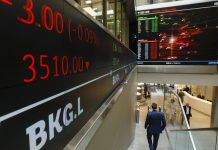The oil industry is usually a pretty boring place to invest. Not lately, though.
Oil prices have been swinging wildly for the past few weeks, but they haven’t swung anywhere close to the $60/barrel they reached in February. And with a global crude oil surplus keeping a lid on prices, most oil companies are looking like risky investments moving forward.
Renewables, on the other hand, are looking like a comparatively solid bet for energy investors. So we asked five of our Motley Fool contributors who follow the energy sector what renewable stocks they’d recommend for investors right now. They came back with Ormat Technologies (NYSE:ORA), Vivint Solar (NYSE:VSLR), Brookfield Renewable Partners (NYSE:BEP), SunPower (NASDAQ:SPWR), and Atlantica Yield (NASDAQ:AY).
Here’s why they think these are top picks in the green energy industry. 
IMAGE SOURCE: GETTY IMAGES.
Unique opportunity in the renewable energy space
Tyler Crowe (Ormat Technologies): Geothermal isn’t talked about much, but it is a compelling power option. It has the baseload consistency of fossil fuels and nuclear, but doesn’t require a fuel input like solar and wind.
The challenge for geothermal is that the upfront costs tend to be high, and facilities are heavily dependent on local geology to be worthwhile. It is by no means a universal power source, but it can fill a niche well and there is plenty of room to grow. By Ormat’s estimates, potential geothermal power locations globally are 10 times that of current installed capacity, about 170 gigawatts. Again, not the numbers for wind and solar, but a huge growth potential for this industry.
That is also what makes Ormat a compelling investment: It is the largest player in this space. Not only does it design and build facilities for utilities, it also has a portfolio of power generating assets it operates under long term power purchase agreements. As of the most recent quarter, its electricity segment amounted to about 75% of revenue and generated a 50% gross margin. This stable, high-margin business has given the company a decent cash engine to pay a modest dividend (currently yielding 0.7%) and invest in larger opportunities like designing and building large scale battery storage facilities.
With a construction pipeline to grow its geothermal baseload by 19% to 24% by 2022 and a nascent battery storage pipeline growing fast, Ormat could make for a compelling investment right now.
Growth and value in rooftop solar
Jason Hall (Vivint Solar): It’s pretty much a certainty that residential and commercial solar installations will fall in the U.S. in the second and perhaps the third quarter. In many places, new solar installation isn’t considered an essential business. Vivint Solar is certainly expecting that. After installing 56 megawatts of solar in last year’s second quarter, the company said it expects to deploy between 35 and 38 megawatts in this year’s second quarter.
Yet despite this precipitous drop in business as fewer businesses and homeowners make the switch to solar, I think investors would do well to buy shares of the company now. To start, I think the market is discounting Vivint shares more than necessary based on the environment. At recent prices, shares are down 55% from the pre-coronavirus crash high, and 10% less than you would have paid for them last year. That’s fair price for the top distributed solar installer in the U.S., a company that will almost certainly return to double-digit growth very quickly once the places its business is locked down are reopened.
Moreover, there’s more value than just a discounted stock price. When Vivint reported first quarter results, CFO Dana Russell said it had $1.2 billion in net retained value, meaning future cash flows it expects to earn from the solar systems it has deployed. That works out to $10 per share. At recent prices, investors can buy that $10 per share in future cash flows for $5.80 per share.
A powerful growth plan
Matt DiLallo (Brookfield Renewable Partners): Brookfield Renewable Partners has a long history of outperforming the market. Since its inception, it has generated a 17% annualized total return, which has torched the S&P 500’s 6% annualized total return during the timeframe. Brookfield has also produced market-beating returns over the last three- and five-year periods. Given that history, it’s usually a good time to buy this top-tier renewable energy stock.
That certainly seems to be the case these days, considering what Brookfield sees ahead. The renewable energy partnership currently anticipates that it can grow its FFO per unit at a 9% to 16% annual rate through at least 2024. Powering that outlook are inflation escalators on its existing contracts, its ability to increase its margins, and a plan to invest $4 billion into development projects and acquisitions. That should give Brookfield the power to grow its high-yielding distribution by 5% to 9% per year.
One thing that’s noteworthy about Brookfield’s plan is it excludes the company’s upcoming acquisition of the rest of TerraForm Power‘s (NASDAQ:TERP) shares that it doesn’t already own. That deal enhances an already strong outlook, which increases the probability that Brookfield can continue outperforming.
Using technology to succeed in solar energy
Travis Hoium (SunPower): There have been a number of strategic changes in the solar industry over the last few years as companies have unwound vertical integration strategies to focus on what they do best. SunPower is no different, selling off its yieldco, abandoning utility-scale solar development, and soon spinning off most of its manufacturing business.
What will be left at SunPower is residential and commercial solar development. In residential solar, the company provides technology, hardware, and services to installation partners. The SunPower Design Studio will design a rooftop solar project in less than a minute, giving more quick information than potential residential solar customers have ever gotten before.
Not only do those solar quotes include SunPower’s high-efficiency solar panels and monitoring, the company is launching energy storage in a growing number of states in 2020. But it’s partners who do the final work of closing and installing rooftop projects.
In commercial solar, SunPower is working directly with customers to build solar projects on roofs and fields near facilities. This business is also adding energy storage, which is attached to about 30% of new projects right now. Commercial solar hasn’t been very profitable for SunPower recently, but after spinning off manufacturing it will have the flexibility to drive costs lower and improve margins, especially as more energy storage is included.
SunPower isn’t a low-risk solar stock by any means. It has to prove to investors that it can improve margins in both residential and commercial markets to return to profitability. But with higher efficiency products than competitors and a head start in digital sales technology, I think it’s built to be a winner long-term.
Right at home for oil investors
John Bromels (Atlantica Yield): A lot of oil industry investors are drawn to the sector by the promise of decent dividend yields from well-established companies. But with plenty of oil and gas dividends being slashed or suspended outright in recent weeks, it’s getting harder and harder to find decent prospects.
Atlantica Yield, a renewable yieldco that currently offers a 7% payout, will be attractive to dividend investors. Formed in 2014, it doesn’t have the pedigree that many oil companies do, but it does operate a diverse group of assets that includes Spanish solar farms, Uruguayan wind farms, Peruvian transmission lines, and water desalination plants in Algeria. Even more impressive, all of its assets are governed by long-term or regulated contracts. And when I say long-term, I mean Atlantica’s next contract expiration date — for any of its assets — is in 2032.
Shares are down about 13% so far in 2020, which looks like an excellent buying opportunity for this diversified, stable dividend payer with excellent growth prospects.
















